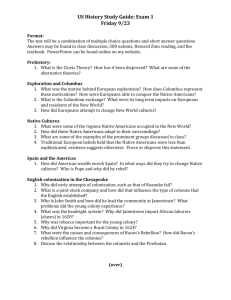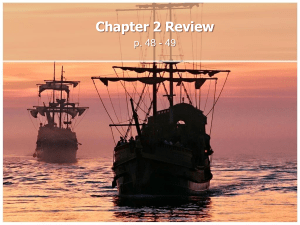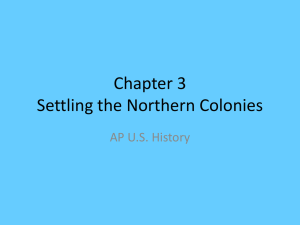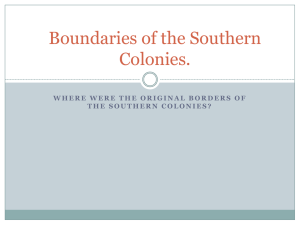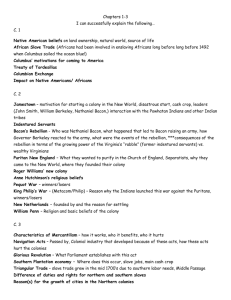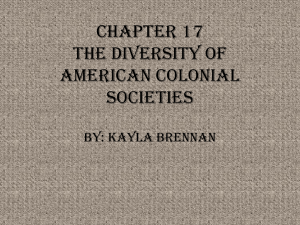Renaissance and Discovery III Unit VI The New World: Empires in
advertisement
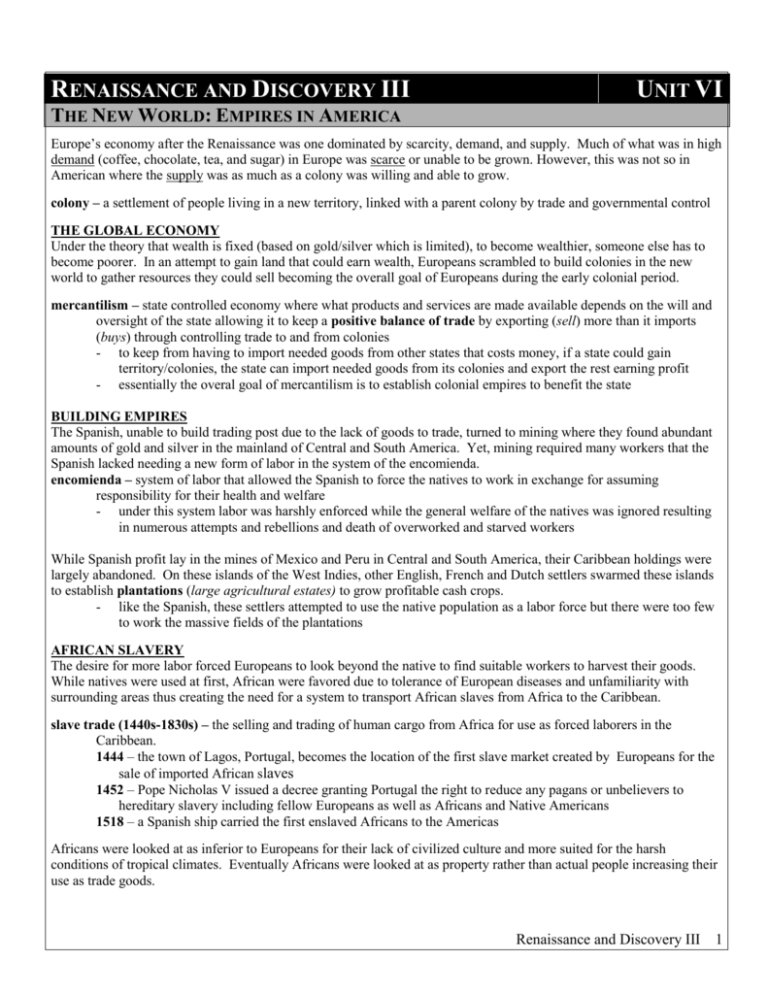
RENAISSANCE AND DISCOVERY III UNIT VI THE NEW WORLD: EMPIRES IN AMERICA Europe’s economy after the Renaissance was one dominated by scarcity, demand, and supply. Much of what was in high demand (coffee, chocolate, tea, and sugar) in Europe was scarce or unable to be grown. However, this was not so in American where the supply was as much as a colony was willing and able to grow. colony – a settlement of people living in a new territory, linked with a parent colony by trade and governmental control THE GLOBAL ECONOMY Under the theory that wealth is fixed (based on gold/silver which is limited), to become wealthier, someone else has to become poorer. In an attempt to gain land that could earn wealth, Europeans scrambled to build colonies in the new world to gather resources they could sell becoming the overall goal of Europeans during the early colonial period. mercantilism – state controlled economy where what products and services are made available depends on the will and oversight of the state allowing it to keep a positive balance of trade by exporting (sell) more than it imports (buys) through controlling trade to and from colonies - to keep from having to import needed goods from other states that costs money, if a state could gain territory/colonies, the state can import needed goods from its colonies and export the rest earning profit - essentially the overal goal of mercantilism is to establish colonial empires to benefit the state BUILDING EMPIRES The Spanish, unable to build trading post due to the lack of goods to trade, turned to mining where they found abundant amounts of gold and silver in the mainland of Central and South America. Yet, mining required many workers that the Spanish lacked needing a new form of labor in the system of the encomienda. encomienda – system of labor that allowed the Spanish to force the natives to work in exchange for assuming responsibility for their health and welfare - under this system labor was harshly enforced while the general welfare of the natives was ignored resulting in numerous attempts and rebellions and death of overworked and starved workers While Spanish profit lay in the mines of Mexico and Peru in Central and South America, their Caribbean holdings were largely abandoned. On these islands of the West Indies, other English, French and Dutch settlers swarmed these islands to establish plantations (large agricultural estates) to grow profitable cash crops. - like the Spanish, these settlers attempted to use the native population as a labor force but there were too few to work the massive fields of the plantations AFRICAN SLAVERY The desire for more labor forced Europeans to look beyond the native to find suitable workers to harvest their goods. While natives were used at first, African were favored due to tolerance of European diseases and unfamiliarity with surrounding areas thus creating the need for a system to transport African slaves from Africa to the Caribbean. slave trade (1440s-1830s) – the selling and trading of human cargo from Africa for use as forced laborers in the Caribbean. 1444 – the town of Lagos, Portugal, becomes the location of the first slave market created by Europeans for the sale of imported African slaves 1452 – Pope Nicholas V issued a decree granting Portugal the right to reduce any pagans or unbelievers to hereditary slavery including fellow Europeans as well as Africans and Native Americans 1518 – a Spanish ship carried the first enslaved Africans to the Americas Africans were looked at as inferior to Europeans for their lack of civilized culture and more suited for the harsh conditions of tropical climates. Eventually Africans were looked at as property rather than actual people increasing their use as trade goods. Renaissance and Discovery III 1 Triangle trade – historical term give to the trade between Europe, Africa and the Americas involving the exporting of goods that were not needed or in excess to another region in exchange for ones that were needed or scarce triangular trade provided a mechanism for correcting trade imbalances EXPORTS Europe to Africa – rum, cloth, manufactured goods Africa to America – slaves America to Europe – cotton, tobacco, sugar, molasses Middle Passage - the middle portion of the triangle trade voyage where the forced transportation of African slaves from Africa to the New World occured - took anywhere from one to four months depending on weather conditions - ships could carry up to 700 slaves aboard one slave ship with nearly 10 million African slaves forced from Africa to the America from 1400-1800s SUCCESS IN THE NEW WORLD While the Spanish led exploration in the New World, they did not grow or prosper as much as their new competitors: the Dutch, French and British. Explanations for why this occurrence happened are among the following: Pirates of the Caribbean – pirates (many of them English like Sir Francis Drake) raided Spanish ships and ports hurting Spanish trade Lack of excitement due to lost voyages (pirates, hurricanes) dampened immigration Mercantilism focused too much on gaining wealth for Spain, but never investing that wealth back into colonies Dutch: the Dutch were the first to explore the eastern seaboard of America near Long Island and the Hudson River establishing a Dutch colony called New Amsterdam at the mouth of the river - outside of the New World, the Dutch had a large and extensive trading empire from Cape Town South Africa to the Spice Islands of Indonesia through the Dutch East India Trading Company France: French merchants were the first to explore and settle the region around the St. Lawrence River and what would become Canada - much like the Spanish, the French didn’t colonize much either, but did make a large profit off fur trading that required friendly relations with the Indians who they bartered with England: like the Dutch, the British too had a large and extensive trading empire outside of the New World in Africa and India through the British East India Trading Company - however in the New World the English settled two separate colonies on the east coast of N. America; one in the south and one in the north: Virginia Colony (southern colony) – was the first English colony in the New World established at Roanoke on the Carolina coast in 1585 for economic reasons - the Roanoke Colony became the “Lost Colony” when after a delayed supply ship returned from England to find the colony abandoned Jamestown (1607) – the first permanent English settlement in America, which prospered after the leadership of John Smith and the harvesting of tobacco introduced by John Rolfe Plymouth Bay Colony (northern colony) (1620) – the second permanent English settlement in America established for religious reasons by a group of pilgrims seeking religious freedom that eventually became the Massachusetts Bay Colony As European nations built these trading empires in the New World, they gave birth to the global economy where small trade between nations was replaced with large trade between continents. This was all made possible by establishing trade colonies along with enforced labor to harvest Europe’s most desired luxury goods. Renaissance and Discovery III 2


